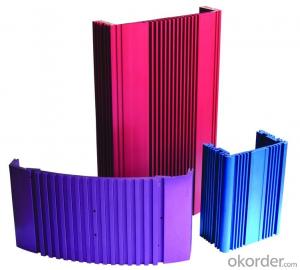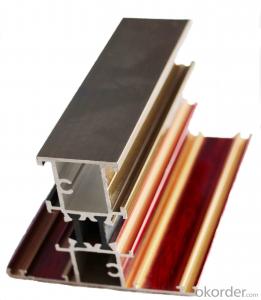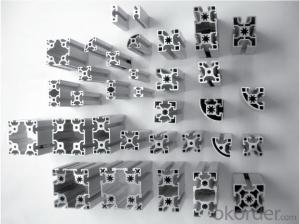Aluminum profiles for doors and windows
- Loading Port:
- China Main Port
- Payment Terms:
- TT OR LC
- Min Order Qty:
- -
- Supply Capability:
- -
OKorder Service Pledge
OKorder Financial Service
You Might Also Like
Quick Details
| Place of Origin: | Brand Name: | Model Number: | |||
| Open Style: | Surface Finishing: | Type: | |||
| Sliding Door Type: | Door Material: | material: |
Packaging & Delivery
| Packaging Detail: | IN CARTON |
| Delivery Detail: | IN 15 DAYS |
Specifications
1)Usages:windows,doors,curtainwalls,solar panel
2)Material:Aluminum Alloy
3)Certificate:CE,ISO9001
Mould | Based on your drawings or use our moule |
| Profile shape | We can design and provide different shape according market order |
| Features | Subtle edges and elegant appearance andeasy processing and installation |
| Fabrication | windows,doors,cutting,drilling |
| Applications | doora/windows,equipment frame and industrial usage |
Goldsword Aluminum Factory | |
Business Type | Aluminium windows and doors profile |
Product series | aluminium windows and doors profile |
Price Determination | Based on Aluminum Ingot Price + Process fee |
Payment Term | T/T, L/C at sight |
Surface Treatment | We can provide aluminum profiles with mill finish, powder coating, anodizing, polishing, sand blasting, electrophoresis and wood color. |
Color | We can provide white, wood color, black, golden, blue, champagne, and other colors as required. |
Packing | Composite paper, Plastic paper, other packing method required by customers is available. 2 to 20 pcs per bundle, sometimes small profiles are plugged in big ones so as to save space for customers. |
Product specification | 1. Alloy: 6063-T5/T6 2. Length: 3-6.5 m 3. Normal anodizing thickness: 8 to 12 micro 4. Normal powder coating thickness: 60 – 100 micro 5. Tensile Strength: ≥160 MPa 6. Yield strength: ≥110 MPa 7. Extensibility: ≥8% 8. Hardness (HW): ≥8 |
1).materies:aluminium alloy
2)grade:6000 series
3)temper:T3-T8
4)certificate:CE,ISO9001:2008
- Q:Can aluminum profiles be an alternative to wood in construction?
- Yes, aluminum profiles can certainly be a viable alternative to wood in construction. Aluminum is lightweight, durable, and resistant to rust and corrosion, making it an excellent choice for various construction applications. Additionally, aluminum profiles offer flexibility in design, are easy to install, and require minimal maintenance. They can be used for structural components, windows, doors, cladding, and other construction elements, providing a sustainable and cost-effective solution compared to wood.
- Q:What are the different extrusion processes used for aluminum profiles?
- Aluminum profiles can be produced using various extrusion processes, each with its own advantages and applications. The most commonly used processes for aluminum profiles are as follows: 1. Direct extrusion: This process involves forcing a heated aluminum billet through a die to form the desired shape. It is widely used and efficient, offering cost-effectiveness and the ability to produce profiles with consistent cross-sections, ranging from simple to complex. 2. Indirect extrusion: In this process, the billet remains stationary while the die moves, pushing the aluminum through the die to create the profile. Indirect extrusion is preferred when intricate internal features, higher surface finish, and tighter tolerances are required. 3. Impact extrusion: Specialized in creating hollow aluminum profiles like tubes or containers, impact extrusion involves placing an aluminum slug in a die and driving a punch into it. The slug flows around the punch to form the desired shape, making it suitable for thin-walled profiles with complex shapes. 4. Hydrostatic extrusion: This cold extrusion process utilizes high-pressure liquid to force the aluminum billet through a die. It is commonly used for producing high-strength profiles with improved mechanical properties and dimensional accuracy. 5. Hot extrusion: The aluminum billet is heated above its recrystallization point and then forced through a die in hot extrusion. This process is ideal for complex-shaped profiles, as the elevated temperature allows for better material flow and deformation. Each extrusion process offers unique benefits and is selected based on the specific requirements of the aluminum profile. Factors such as shape, complexity, surface finish, tolerances, and mechanical properties all play a crucial role in determining the most suitable extrusion process.
- Q:Are aluminum profiles suitable for exhibition displays?
- Yes, aluminum profiles are highly suitable for exhibition displays. They are lightweight, durable, and can be easily customized to fit various display requirements. Aluminum profiles also offer a sleek and modern aesthetic, making them ideal for creating visually appealing exhibition displays. Additionally, they are versatile and can be easily assembled and disassembled, allowing for easy transportation and setup at different exhibition venues.
- Q:Are there any specific safety precautions when working with aluminum profiles?
- Working with aluminum profiles requires specific safety precautions that should be considered. Here are some important precautions to keep in mind: 1. Personal Protective Equipment (PPE): It is vital to wear appropriate PPE, such as safety glasses, gloves, and protective clothing, to safeguard against potential injuries. Aluminum chips or shavings can cause cuts or abrasions. 2. Ventilation: Ensure that the working area has proper ventilation to prevent the accumulation of aluminum dust or fumes. Aluminum dust can be combustible, and inhaling aluminum fumes can result in respiratory problems. 3. Fire Safety: Due to its high flammability, it is crucial to have fire prevention measures in place. Keep a fire extinguisher nearby and avoid sparks or open flames near aluminum profiles. Choose non-sparking tools and be cautious of excessive heat during cutting or welding processes. 4. Handling and Storage: Aluminum profiles can be heavy, so it is important to use correct lifting techniques to avoid back or muscle injuries. Store aluminum profiles securely and in an organized manner to minimize the risk of tripping or falling. 5. Cutting and Machining: When cutting or machining aluminum profiles, use appropriate tools and techniques. Ensure that the material is securely clamped before any cutting operation to prevent movement and potential accidents. 6. Ergonomics: Prioritize maintaining good ergonomics while working with aluminum profiles to reduce the risk of repetitive strain injuries or musculoskeletal disorders. Utilize ergonomic tools or equipment to minimize strain on the body. 7. Training and Knowledge: It is essential to undergo proper training and acquire knowledge about working with aluminum profiles. Understand the specific properties of aluminum and the associated hazards to work safely and efficiently. By adhering to these safety precautions, the risk of accidents, injuries, or health hazards when working with aluminum profiles can be significantly reduced.
- Q:What are the different surface engraving options for aluminum profiles?
- Aluminum profiles have several options available for surface engraving. Some of the most common techniques include: 1. Laser engraving: Achieving precise and clean results, laser engraving uses a high-powered laser to etch intricate patterns and fine details onto the aluminum profile. 2. Diamond drag engraving: Also known as diamond scratch engraving, this method scratches shallow grooves onto the surface of the aluminum profile using a diamond-tipped tool. It is suitable for creating logos, serial numbers, or simple designs. 3. Chemical etching: Custom designs, patterns, or textures can be created on the aluminum profile by using a chemical solution to selectively remove specific areas. 4. Mechanical engraving: A rotating cutting tool is used to engrave the aluminum profile in this method. It is commonly used for basic text or simple designs and can be performed manually or with the assistance of a CNC machine. 5. Sandblasting: By shooting a high-pressure stream of sand or other abrasive materials onto the surface of the aluminum profile, sandblasting creates a textured surface and achieves a matte or frosted finish. Each of these engraving options offers unique benefits and should be chosen based on the desired outcome, complexity of the design, and budget considerations. When selecting the most suitable engraving method for aluminum profiles, it is important to consider factors such as durability, precision, and aesthetic appeal.
- Q:How about the price of aluminum profile?
- Aluminum prices are calculated according to the price of aluminum ingot + processing fees, such as: aluminum ingot price 16000+, processing fee 6000 = 22000 yuan / ton
- Q:80 series insulation aluminum broken bridge 1.4 thick, one square kilogram, how many kilograms aluminum material?
- Each brand of profiles, aluminum weight is not the same, but within the unit area is about 8 kilograms, little difference
- Q:How do aluminum profiles perform in terms of corrosion resistance?
- Aluminum profiles are known for their excellent corrosion resistance. Due to the formation of a protective oxide layer on the surface, aluminum profiles are highly resistant to corrosion, even in harsh environments. This oxide layer acts as a barrier, preventing further oxidation and corrosion. Additionally, aluminum profiles can be further enhanced through various surface treatments such as anodizing or powder coating, which provide additional protection against corrosion. Overall, aluminum profiles offer exceptional corrosion resistance, making them suitable for a wide range of applications, including construction, transportation, and manufacturing industries.
- Q:What are the different types of corner connectors used with aluminum profiles?
- Aluminum profiles commonly utilize several types of corner connectors for joining. These connectors facilitate the creation of diverse structures like frames, enclosures, and shelving units. One prevalent corner connector is the 90-degree angle bracket. It possesses a right angle shape with holes on each side to accommodate screws or bolts for fastening the profiles together. The 90-degree angle bracket is adaptable and suitable for various applications. Another corner connector is the 45-degree angle bracket, similar to the 90-degree angle bracket but designed for a 45-degree angle joint between profiles. It finds use in applications requiring slanted or angled structures. T-slot corner connectors are also popular. They have a T-shaped slot for easy insertion of profiles. These connectors are ideal for applications that prioritize adjustability and flexibility, allowing for effortless repositioning and modification of the structure. Some corner connectors are specifically designed for particular profile types, such as the end cap connector. This connector caps off the profile's end, providing a polished appearance and protection against damage. Furthermore, various other corner connectors exist, including corner gussets, angle plates, and corner brackets. Each connector type offers unique features and advantages, catering to different applications and requirements. In summary, the assortment of corner connectors available for aluminum profiles offers a wide range of options for joining and assembling structures. These connectors provide strength, stability, and versatility, making them indispensable components in aluminum profile-based construction projects.
- Q:What are the surface finishes available for aluminum profiles?
- Aluminum profiles offer a range of surface finishes, each with distinct aesthetics and properties. The options for surface finishes include: 1. Mill Finish: This is the standard finish straight from the mill, without any additional treatment. It has a raw look with visible manufacturing marks and is typically used for structural purposes where appearance is not important. 2. Anodized Finish: This finish involves an electrochemical process that forms a protective oxide layer on the aluminum surface, enhancing corrosion resistance and durability. Anodized finishes come in different colors and can have a glossy or matte appearance, making them popular for decorative applications. 3. Powder Coating: This finish involves applying dry powder to the aluminum surface and then curing it in an oven. It offers excellent durability, corrosion resistance, and a wide range of color options. It can also provide different textures, including smooth, matte, or textured, allowing for customization based on specific design needs. 4. Brushed Finish: Achieved by brushing the aluminum surface with abrasive materials, this finish creates fine lines for a brushed appearance. It is often used to add a decorative touch to aluminum profiles and can provide a sleek and modern look. 5. Polished Finish: Polishing entails using abrasive materials to create a smooth and shiny surface on the aluminum. This finish can range from high gloss, mirror-like appearance to a satin finish. It is commonly used in architectural applications where a reflective and visually appealing surface is desired. 6. Wood Grain Finish: This finish involves applying a special coating to the aluminum surface, imitating the look of wood grain. It provides a natural and warm appearance, making it suitable for applications where a wood-like aesthetic is desired without the maintenance requirements of real wood. These examples showcase the variety of surface finishes available for aluminum profiles. The selection of a finish depends on the intended use, desired appearance, and specific requirements such as corrosion resistance, durability, and ease of maintenance.
1. Manufacturer Overview |
|
|---|---|
| Location | |
| Year Established | |
| Annual Output Value | |
| Main Markets | |
| Company Certifications | |
2. Manufacturer Certificates |
|
|---|---|
| a) Certification Name | |
| Range | |
| Reference | |
| Validity Period | |
3. Manufacturer Capability |
|
|---|---|
| a)Trade Capacity | |
| Nearest Port | |
| Export Percentage | |
| No.of Employees in Trade Department | |
| Language Spoken: | |
| b)Factory Information | |
| Factory Size: | |
| No. of Production Lines | |
| Contract Manufacturing | |
| Product Price Range | |
Send your message to us
Aluminum profiles for doors and windows
- Loading Port:
- China Main Port
- Payment Terms:
- TT OR LC
- Min Order Qty:
- -
- Supply Capability:
- -
OKorder Service Pledge
OKorder Financial Service
Similar products
New products
Hot products
Hot Searches
Related keywords




























